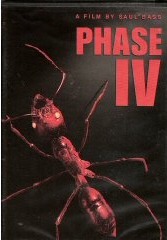
The Nature Amock! Sub-genre has long been a fear fan favorite, rearing its ugly head in every cinematic age to varying degrees of success and screams. Harkening back to our primal past when we had very good reason to fear the gnashing of teeth in the dark, and were often served up at the main course on the forest's food chain, stories of drooling, large fanged beasts easily made the transition from campfire folklore and fiction to the gory glories of the silver screen. Surprisingly, though, insects have been featured in more fright films than such predators as bears or lions. Appearing in the fifties as by-products of Faustian nuclear testing or other results of mad science, such nasties as spiders, flies, and scorpions made the creature feature rounds with style. The thematic tide began to change in the 60s and 70s, as political consciousness latched onto the environmental question, merging the traditional monster movie message of "man wasn't meant to explore too far" with the devastating effects of corporate greed and the frighteningly possible suggestion that nature itself -- through chance or design -- was capable of summoning up horrors every bit as frightening as ghouls or vampires. The best of these pictures (Day of the Animals, for instance) combined this ecological message with suspense and both physical and emotional horror, enveloping their graphic and more sensationalistic thrills in pseudo-science and humanism. Phase IV, while pulling of the plausibility angle and making its story of intelligent ants plausible, fails to create any true terror. The story is simply too slow and drawn out, with lacklustre dialogue taking the place of action and long winded descriptions overshadowing the shudder potential of millions of malicious ants.
Good old Mother Nature, pissed at mankind (or maybe just having a bad hair day), has altered the earth's ant population. The insects are beginning to communicate in an unprecedented fashion, working together even with their natural enemies. This turn of events suggests to Biologist Dr. Ernest Hubbs the gathering of a collective mind . . . which bode good for our species. Together with numeral language and research specialist James Lesko, Hubbs travels to the small and depopulated desert town of Paradise City, hoping to research this phenomena. A barren landscape has replaced the tourist attractions that at one time proliferated the area. People have been driven away by hordes of the super intelligent ants. And the little beggars have built eerie monoliths that reach to the scorching sky. Hubbs and Lesko conduct their research in a domed building near these earthen landmarks, and as James works on mathematical communication with the ants, Dr. Hubbs destroys their towers in hopes that they will respond. It soon becomes a battle between men and insects as the ants create new monoliths with mirrored surfaces; these bounce sunlight off the research station, raising the temperature. The scientists are joined by Kendra, a young girl whose family was killed fleeing a vicious ant siege. Will this trio find the secret to defeating this insect mob or will the deadly ants supersede our place as world rulers?
Not without its late-night chiller charms, Phase IV is a poor follow up to the truly classic sci-fi horror hybrids upon which it is obviously modelled. While there are several scenes of ants crawling around that may make the hairs stand still on fans with a fear of insects, these scenes quickly become routine, lacking any true sense of mounting dread or tension. Whereas Empire of the Ants and its more effective cousin Them! effectively milked the mutated condition of its insects and emphasized the life-and-death struggle of people attempting to survive nature gone awry, this uncertain thriller is more content to theorize about the ensuing danger than creating suspense. The director spends more time making characters hob-knob in sterile laboratory environments than 'acting.' Even the ecological theme becomes lost. On a more positive note, the insect photography is superb (if, again, not very frightening), captured with precision and inventiveness by Ken Middleham. His work and the filmmaker's success in keeping the science fictional elements grounded in everyday reality is admirable. If only this insistence on realistic effects and setting had been transferred to the characters, enlivened by a sense of dramatic structure and effective pacing! One manner in which the narrative is successful is the writer's resolve to keep the cataclysmic reasons for the insect's superiority and its implications ambiguous, squeezing a general feeling of unease from the material.
It is rumoured that a longer cut of the film and a different ending exists (running perhaps over 90 minutes), but these supposed nods to Stanley Kubrick's use of space and image haven't yet shown up on any official home market releases. In the meantime, this Legend presentation should please fans of this well-meaning if ineffectual little chiller. Phase IV is featured in 1.78:1 widescreen (anamorphic), with believable colors and a largely crisp image soured only by occasional hints of grain. The Mono English soundtrack is clean and without background interference. If not as commendable as their rescue of such obscurities as The Skull or The Man Who Could Cheat Death, Legend Film's unearthing of this obscure eco-horror movie is still appreciated, leaving one to hope that many more cult gems will be rescued in the near future.
Review by William Simmons
| Released by Legend Films |
| Region 1 - NTSC |
| Not Rated |
| Extras : |
| see main review |